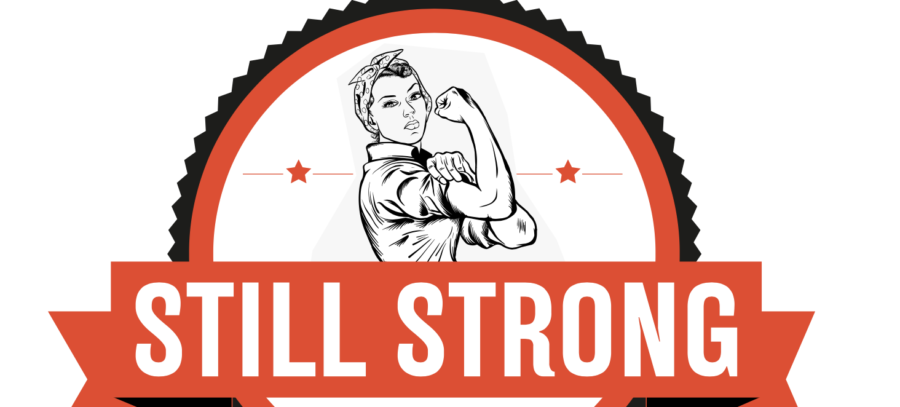In January, Virginia teacher Nicole Loch attended a #RedForEd rally at the statehouse in Richmond. She arrived on a charter bus sponsored by the Fauquier Education Association (FEA), even though Loch had never joined the union—a decision she had resisted for 11 years. “It was a bus full of other educators from my county,” says Loch, a civics teacher at Auburn Middle School in Warrenton.
“When I got to Richmond, I saw the power of mobilization and strength in numbers,” she says. “I knew then I needed to join.”
Loch marched and chanted for a mile—from Monroe Park to the capitol steps—where the crowd numbered 4,000. Standing there—holding a sign with the words “I Teach, I Matter”—she realized that many of the 250 FEA members at the rally had been meeting for months to organize their road trip, produce T-shirts and signs, and arrange meetings in the offices of legislators to discuss education policy and funding in Fauquier County.
 Longtime teacher Nicole Loch joined her local association the day after attending a statehouse #RedForEd rally. (photo: Philippe Nobile)
Longtime teacher Nicole Loch joined her local association the day after attending a statehouse #RedForEd rally. (photo: Philippe Nobile)
“I felt I had been left behind,” she says. “I had no idea what people in my county had been doing to prepare for the event because I wasn’t a part of FEA.”
A mere 24 hours after the rally, Loch had joined FEA and the Virginia Education Association (VEA)—the state’s largest educator union.
“Being an FEA member has emboldened me to speak out about the value of public education and demand action from local officials to do what’s best for children and educators,” says Loch, who became a building representative soon after joining FEA.
The Perfect Civics Lesson
Loch attended the rally, she says, because she wanted to show her students what it means to advocate for public schools.
“I teach them to exercise their First Amendment rights and speak out when they see injustice,” she says.
Loch had read about the massive 2018 educator walkouts in “red” conservative states like Kentucky, Oklahoma, and West Virginia, which attracted 26,000, 45,000, and 35,000 protesters respectively. Within months, 267,000 more educators in Arizona, Colorado, and North Carolina organized walkouts. She heard how educators, with the support of their unions, attracted public support and forced reluctant legislators to invest in schools and increase educator pay.
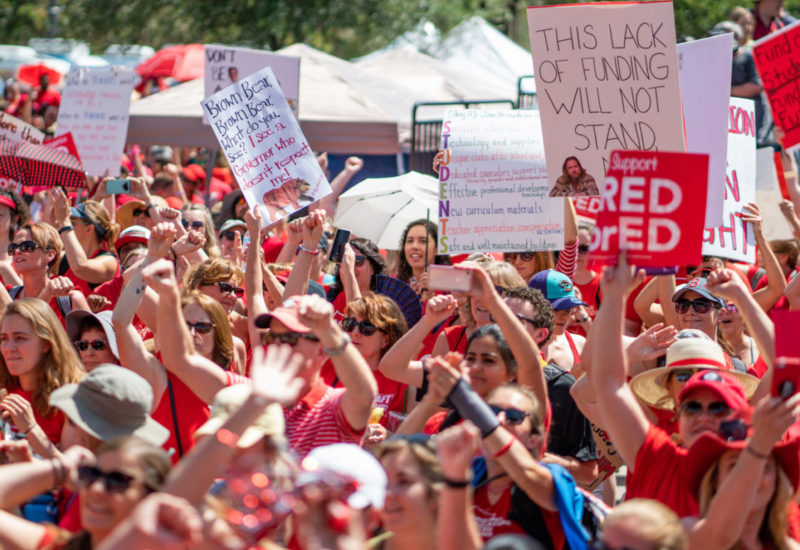 Arizona educators rally for school funding in April 2018.
Arizona educators rally for school funding in April 2018.
The perfect civics lesson fell into Loch’s lap when Oklahoma educators took their fight to the polls last November and ceremoniously ousted 15 of 19 legislators in the state House. Why? They had voted against raising taxes to fund education. The previous spring, Oklahoma educators had organized a nine-day #RedForEd protest that ended when lawmakers approved a tax increase to pay for $6,100 average pay raises for teachers and $1,250 raises for education support professionals (ESPs).
According to the U.S. Bureau of Labor Statistics (BLS), U.S. workers initiated work stoppages only seven times in 2017, the second-fewest since the agency started keeping records in the 1940s.
In 2018, aggrieved educators, parents, and other community members participated in 20 walkouts. That’s nearly three times the amount of the previous year. In addition to walkouts, innovative organizing strategies, social media campaigns, and town hall meetings have marked a new labor movement unseen in a generation.
Looking back, Loch says she was impressed by the solidarity of colleagues across the country but not enough to join her own union in the Commonwealth, a right-to-work state.
“I earn below what a professional with 11 years’ experience and a master’s degree should make,” she says. “I couldn’t make sense of the expenditure.”
Power in Numbers
The U.S. Supreme Court handed down the Janus v. AFSCME (American Federation of State, County, and Municipal Employees) decision last June. The plaintiff, Mark Janus, was an Illinois state employee who received the raises and benefits negotiated by his union. The ruling allows him and other public sector workers the right to benefit from union contracts without having to pay their fair share for that representation.
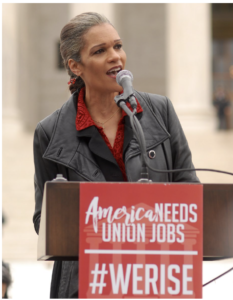 Maryland teacher Kember Kane speaks at a rally outside the U.S. Supreme Court in February 2018 during Janus deliberations. (photo: Jay Mallin)
Maryland teacher Kember Kane speaks at a rally outside the U.S. Supreme Court in February 2018 during Janus deliberations. (photo: Jay Mallin)
Janus overturned Abood v. Detroit Board of Education—the 1977 case in which the court unanimously upheld fair share fees that support collective bargaining. Each state was left to decide whether to permit such fees. With Abood, workers who didn’t want to join a union didn’t have to. Rather, they paid a reduced “fair share fee” or “agency fee” to cover the cost of union representation and bargaining services that unions provide for the benefit of all employees. Such fees were reduced amounts charged to workers who opted out of union membership. By law, the fees could not be used for political purposes.
“There are many educators in my building—as in many schools—who don’t know how powerful they are until they organize,” says Loch. Since the Janus ruling, almost 30 new members have joined FEA, bringing total membership to 460.
Bargaining for the Common Good
NEA had projected a loss of as many as 200,000 members in addition to 90,000 agency-fee payers after the Supreme Court decision. Instead, as of March, more than 217,000 new members had joined NEA since the Janus decision, and the Association has more members today than it did last year before the Court’s decision. The American Federation of Teachers (AFT), with 1.7 million members, added 88,500 members by the beginning of this year, which offset the 84,000 agency-fee payers the union lost after the ruling. Even case defendant AFSCME reports that for every member opting out since Janus, the union has gained seven new members.
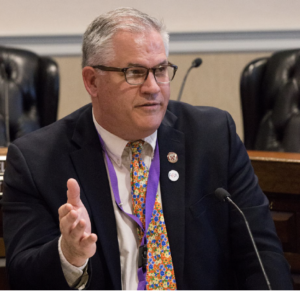 Superintendent David Jeck granted educators of Fauquier County Public Schools professional leave to attend the January #RedForEd rally in Richmond. Jeck is an FEA member. (photo: Philippe Nobile)
Superintendent David Jeck granted educators of Fauquier County Public Schools professional leave to attend the January #RedForEd rally in Richmond. Jeck is an FEA member. (photo: Philippe Nobile)
Almost 15 million Americans still pay dues to unions, according to BLS. Increasingly, those unions are supporting campaigns that benefit the entire community. Across the country, unions are helping to champion improved public transportation, healthcare, and public education.
In the nation’s new non-agency fee environment, NEA has supported grassroots #RedForEd movements by providing expertise in digital communications, logistics, member mobilization, research, and legislative strategy. In states across the nation, NEA has helped parents, students, and educators win billions of dollars in increased funding for public schools.
Since 2014, the NEA Center for Organizing has worked with local and state affiliates to develop union leaders, expand membership, and engage educators. Through Education Summer, for example, the center trains members for six to eight weeks to become education organizers who can identify local issues, recruit new members, and establish community relationships.
The center’s New Educator Campaign is another example of NEA’s efforts to recruit and retain members. Operating year-round, the campaign works with incoming teachers, ESPs, higher education members, and association leaders to build a culture of organizing in a post-Janus world of voluntary union membership.
At the state level, for example, more than 19,000 North Carolina educators with support from NEA rallied last year in downtown Raleigh to demand better pay and increased funding for public schools. The power of collective action was exhibited again in Raleigh at a second march in May with 20,000 more educators in attendance.
On a local level, the California Federation of Teachers funds the Alliance of Californians for Community Empowerment (ACCE)—an advocacy group for low-income communities of color. Before Los Angeles teachers organized a walkout in January, ACCE members and other groups—like Reclaim Our Schools LA—articulated demands for smaller class sizes, reduced random student searches, and more social services, that the union brought to the bargaining table—and won.
'Janus' Was Personal
Nationwide, educators are publicly and audaciously voicing their opinions about how to recruit, support, and retain teachers, ESPs and higher education members.
Officials with NEA-Rhode Island (NEARI) had predicted a 20 to 30 percent membership loss in the first year after Janus. Instead, NEARI had gained about 275 members by March.
Sarah Markey is a NEARI UniServ director, and co-presenter of a workshop titled, “Engaging ESPs After Janus.”
"After the Janus decision, we were heartbroken,” says Markey. “It felt very personal, intended to hurt the people we care about most: educators and students.”
Markey’s co-presenter, Kristin Chase, is president of the 160-member East Providence Teachers Assistants (EPTA). Statewide, she says members were prepared for a worst-case scenario after Janus.
“I’m happy to say that a vast majority of our locals remained steady,” says Chase, who is the NEARI vice president for ESPs. “We saw no noticeable difference in any membership category.”
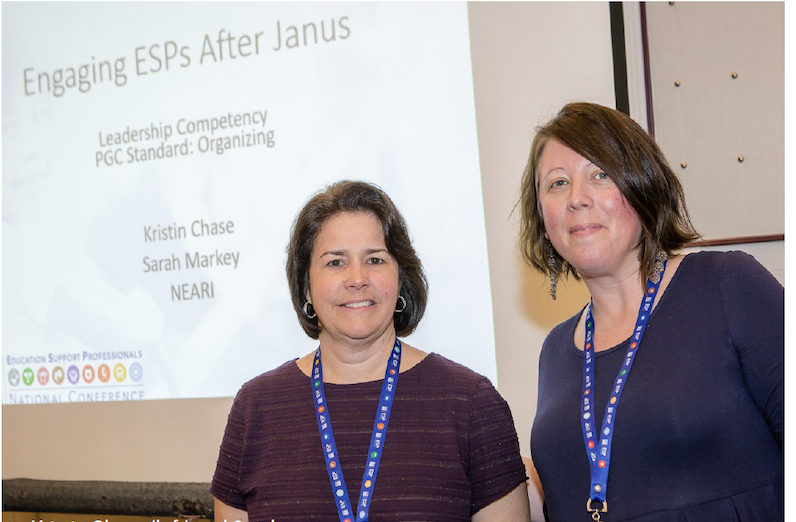 Kristin Chase (left) and Sarah Markey of Rhode Island conducted a workshop at the
Kristin Chase (left) and Sarah Markey of Rhode Island conducted a workshop at the
NEA ESP conference in March involving the 'Janus' ruling.
Chase and Markey say this positive result is due primarily to one-on-one member engagement, which they stress in their presentation.
“Getting more members to step into leadership roles is a huge component in sustaining active participation for the long term,” says Chase, who helped EPTA achieve 100 percent membership.
Anti-union organizations, think tanks, and right-wing activists backed by corporate donors, including ultra-conservative billionaire David Koch and his brother Charles, U.S. Secretary of Education Betsy DeVos and her family, and the Bradley Foundation, had long been preparing for a case like Janus as part of a larger campaign to undermine the power of unions.
On the heels of the Janus decision, these anti-union forces have funded dozens of lawsuits across the country designed to weaken the labor movement. And with an increasingly partisan judiciary, unions cannot rely on the courts to do justice.
“It is the continued activism of educators that will lead to a better future for public schools and students,” says Markey.
Stay Ready
“It’s clear that corporate interests want to get educator associations out of their way,” says Brian Nelson, who is president of NEA-South Kingstown (NEA-SK), and a math teacher at Curtis Corner Middle School in South Kingstown. “Their goal is to privatize the education system and turn it into a profit bearing institution.”
In the months before the Janus ruling, Nelson attended educator meetings and union gatherings at schools across the district to discuss the ramifications of the case.
“I explained that if collective bargaining is weakened or eliminated, it would impact their salaries, health care quality, retirement benefits and workplace environment,” he says. “We didn’t lose members after the Janus decision. No one opted out.”
To increase their community presence, and to enhance their own team spirit, many of the 310 members of NEA-SK bowl together and organize other social outings. “At times, I felt each school was on its own island,” Nelson says. “Bowling nights help to bring us together and provide community members with the opportunity to approach us and discuss our work with students.
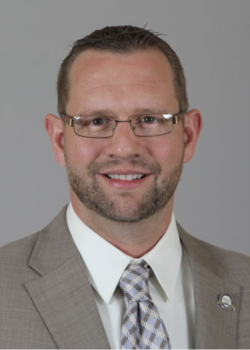 Brian Nelson welcomes the new post-'Janus' era.
Brian Nelson welcomes the new post-'Janus' era.
While building a more public profile, NEA-SK members have already won a formidable victory. Last November, four candidates endorsed by NEA-SK for the school committee won by large margins.
“The election was our golden opportunity to create the change that our members and the students of our district deserve,” Nelson says.
Approximately 865 NEARI members reside in South Kingstown—even though they work in other towns and belong to other locals. If spouses and domestic partners are included, the number jumps to 1,730 allies.
“We capitalized on that affiliation and had a strong showing on Election Day that flipped the council,” says Nelson. One of the council members elected was NEARI’s Sarah Markey.
NEA continues to work to support affiliates across the country as they plan collective actions on behalf of their students and schools. This work is the manifestation of New Business Item 48, passed by delegates to last year’s NEA Representative Assembly. The measure called on NEA to support a national campaign of labor action to save public services, fight for union rights, and improve NEA members’ living and working conditions. Educators in affiliates nationwide are leading the campaign. And NEA is helping them win.
“It’s been amazing to see what educators are doing for their schools, students, and communities,” says Markey.
Empowered Educators
About 250 people attended a March budget meeting of the Fauquier County Board of Supervisors in Warrenton, Va., many of them wearing red T-shirts with the words, “Advocates for Change.”
All but one of the 46 speakers addressed education funding, teacher and ESP pay, campus facility upgrades, and other school issues.Two days later, at a joint work session between the board of supervisors and county school board, FEA President Lauren Brill sat in the front row with FEA colleagues Carolyn Leach and Bobby Jenkins.
“Until recently, people felt like they weren’t being heard,” says Brill, a teacher at Margaret M. Pierce Elementary School in Remington. “Richmond was a spark for change."
"However, being heard and being funded are two different things," she adds.
Virginia is the 11th wealthiest state in the nation and ranked by Forbes magazine as Number One for business. Yet, the state ranks 42nd in per-pupil state funding and 32nd in teacher pay.
“Virginia teachers are paid about $8,500 less than the national teacher’s average salary,” says Superintendent David Jeck, who granted professional leave to educators wanting to attend the rally. “With regard to state funding for schools, we are still below 2009 levels when adjusted for inflation.”
In Virginia, teacher pay scales can vary from one county to the next due to state funding, property values, and variations in local tax policies. In neighboring Loudoun County, for example, a first-year teacher with a master’s degree earns $55,941 per year, or about $1,000 more than a teacher in Fauquier County with a master’s degree and more than 10 years’ experience.
Together with a higher cost of living, four out of 10 educators are forced to live outside the area where they work, says Leach, a teacher at C. Hunter Ritchie Elementary School in Warrenton, who lives in neighboring Midland.
“The state does not give us that much funding,” she says. “This affects school conditions, pay scales, and where people can afford to live.”
 FEA members Carolyn Leach (left), Bobby Jenkins, and Lauren Brill meet regularly with school administrators. (photo: Philippe Nobile)
FEA members Carolyn Leach (left), Bobby Jenkins, and Lauren Brill meet regularly with school administrators. (photo: Philippe Nobile)
Superintendent Jeck is a former teacher, coach, and principal, and current FEA member.
“It just made sense to join FEA,” says Jeck, who wore a red T-shirt at the Richmond rally and addressed the crowd on behalf of Fauquier County educators. “Their messaging is right.”
Jeck and Brill often meet informally to discuss education issues. They share pride in the county’s 96 percent graduation rate, close-knit community, and collaboration between educators and administrators.
“We have monthly sit-downs,” says Brill.
Jenkins is a county school bus driver and FEA’s vice president. He and other ESPs meet with FEA member and Assistant Superintendent David Graham at least once a month for breakfast.
“He (Graham) use to drive a school bus,” Jenkins says. “We understand each other.”
As in many parts of the country, Virginia educators have not been discouraged by Janus or any other anti-worker, anti-union court rulings. Instead, they took matters into their own hands, taking the battle to the steps of the statehouse and the public sphere. They signed up new union members, rallied against the underfunding of public schools, and joined a labor movement with broad public support.
“Wherever you live in this country, policy makers need to hear from us and be held accountable,” says Jenkins. “The union gives us leverage and a voice.”
